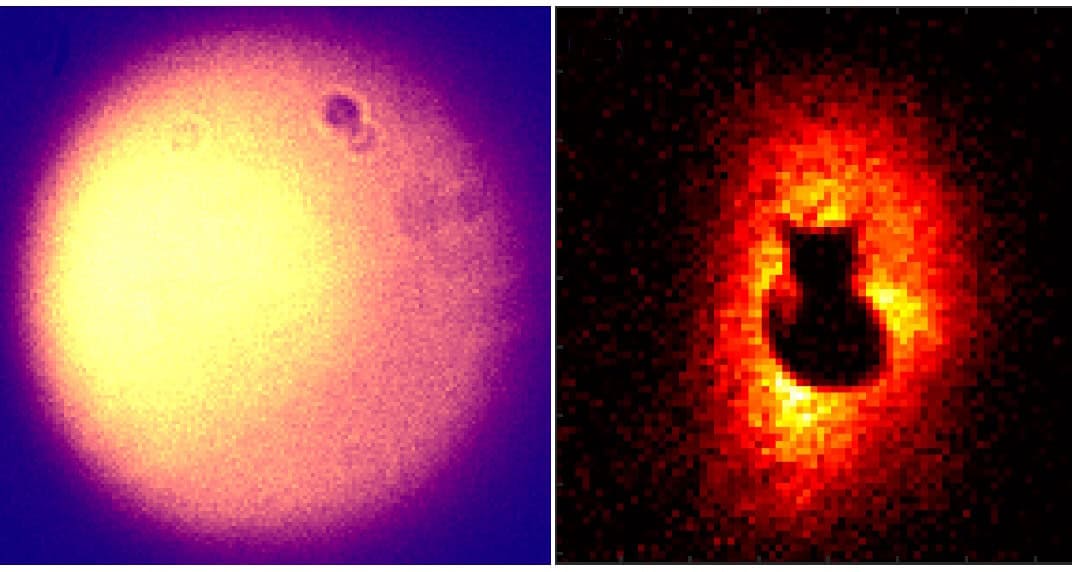Picking winners: the 10 most popular physics stories of 2024
What makes a physics story popular? The answer is partly hidden in the depths of Internet search algorithms, but it’s possible to discern a few trends in this list of the 10 most read stories published on the Physics World website in 2024. Well, one trend, at least: it seems that many of you really, really like stories about quantum physics. Happily, we’ll be publishing lots more of them in 2025, the International Year of Quantum Science and Technology. But in the meantime, here are 2024’s most popular stories – quantum and otherwise.
10. A quantum thought experiment that continues to confound
As main characters in quantum thought experiments go, Wigner’s friend isn’t nearly as well-known as Schrödinger’s cat. While the alive-or-dead feline was popularized in the mid-20th century by the science fiction and fantasy writer Ursula K LeGuin, Wigner and his best mate remain relatively obscure, and unlikely to appear in an image created with entangled light (more on this later). Still, there’s plenty to ponder in this lesser-known thought experiment, which provocatively suggests that in the quantum world, what’s true may depend, quite literally, on where you stand: with Wigner’s friend inside a lab performing the quantum experiment, or with Wigner outside it awaiting the results.
9. A record-breaking superconductor that wasn’t
Popularity isn’t everything. This story focused on a paper about a high-temperature superconducting wire that appeared to have a current density 10 times higher than any previously reported. Unfortunately, the paper’s authors made an error when converting the magnetic units they used to calculate current density. This error – which the authors acknowledged, leading to the paper’s retraction – meant that the current density was too high by… well, by a factor of 10, actually.
Surprisingly, this wasn’t the most blatant factor-of-10 flop to enter the scientific literature this year. That dubious honour belongs to a team of environmental chemists who multiplied 60 kg x 7000 nanograms/kg to calculate the maximum daily dose of potentially harmful chemicals, and got an answer of…42 000 nanograms. Oops.
8. Exploiting quantum entanglement to create hidden images

Remember the entangled-light Schrödinger’s cat image? Well, here it is again, this time in its original context. In an experiment that made it onto our list of the top 10 breakthroughs of 2024, researchers in France used quantum correlations to encode an image into light such that the image only becomes visible when particles of light (photons) are observed by a single-photon sensitive camera. Otherwise, the image is hidden from view. It’s a neat result, and we’re glad you agree it’s worth reading about.
7. An icy exoplanet with an atmosphere
At this time of year, some of us in the Northern Hemisphere feel like we’re inhabiting an icy exoplanet already, and some of you experiencing Southern Hemisphere heat waves probably wish you were. Sadly, none of us is ever going to live on (or even visit) the temperate exoplanet LHS 1140 b, which is located 49 light-years away from Earth and has a mass 5.6 times larger. Still, astronomers think this watery, icy world could be only the third planet (after Earth and Mars) in its star’s habitable zone known to have an atmosphere, and that was enough to pique readers’ interest.
6. Vortex cannon generates toroidal electromagnetic pulses

An electromagnetic vortex cannon might sound like an accessory from Star Trek. In fact, it’s a real object made from a device called a horn microwave antenna. It gets its name because it generates an electromagnetic field in free space that rotates around the propagation direction of the wave structure, similar to how an air cannon blows out smoke rings. According to its inventors, the electromagnetic vortex cannon could be used to develop communication, sensing, detection and metrology systems that overcome the limitations of existing wireless applications.
5. Why our world (still) cannot be anything but quantum
Returning to the quantum theme, the fifth-most-read story of 2024 concerned an experiment that demonstrated a new violation of the Leggett-Garg inequality (LGI). While the better-known Bell’s inequality describes how the behaviour of one object relates to that of another object with which it is entangled, the conceptually similar LGI describes how the state of a single object varies at different points in time. If either inequality is violated, the world is quantum. Previous experiments had already observed LGI violations in several quantum systems, but this one showed, for the first time, that neutrons in a beam must be in a coherent superposition of states – a fundamental property of quantum mechanics.
4. ‘Hidden’ citations conceal the true impact of scientific research

When a scientific paper introduces a concept that goes on to become common knowledge, you might expect later researchers to cite the living daylights out of it – and you would be wrong. According to the study described in this article, the ideas in many such papers become so well known that the opposite happens: no-one bothers to cite them anymore.
This means that purely citation-based metrics of research “impact” tend to underestimate the importance of seminal works such as Alan Guth’s 1981 paper that introduced the theory of cosmic inflation. So if your amazing paper isn’t getting the citation love it deserves, take heart: maybe it’s too foundational for its own good.
3. Unifying gravity and quantum mechanics without the need for quantum gravity
Physicists have been trying to produce a theory that incorporates both gravity and quantum mechanics for almost a century now. One of the sticking points is that we don’t really know what a quantum theory of gravity might look like. Presumably, it would have to combine the world of gravity (where space and time warp in the presence of massive objects) with the world of quantum mechanics (which assumes that space and time are fixed) – but how?
For the University College London theorist Jonathan Oppenheim, this is the wrong question. As this article explains, Oppenheim has developed a new theoretical framework that aims to unify quantum mechanics and classical gravity – but, crucially, without the need to define a theory of quantum gravity first.
2. Open problem in quantum entanglement theory solved after nearly 25 years
Can a quantum system remain maximally entangled in a noisy environment? According to Julio I de Vicente from the Universidad Carlos III de Madrid, Spain, the answer is “no”. While the question and its answer might seem rather esoteric, this article explains that the implications extend beyond theoretical physics, with so-called “maximally entangled mixed states” having the potential to revolutionize our approach to other problems in quantum mechanics.
1. The ‘magic’ of quantum computation
The science fiction writer Arthur C Clarke famously said that “Any sufficiently advanced technology is indistinguishable from magic.” Sadly for Clarke fans, the magic in this article doesn’t involve physicists chanting incantations or waving wands over their experiments. Instead, it refers to quantum states that are especially hard to simulate on classical machines. These so-called “magic” states are a resource for quantum computers, and the amount of them available is a measure of a system’s quantum computational power. Indeed, certain error-correcting codes can improve the quality of magic states in a system, which makes a pleasing connection between this, the most-read article of 2024 on the Physics World website, and our pick for 2024’s “Breakthrough of the year.” See you in 2025!
The post Picking winners: the 10 most popular physics stories of 2024 appeared first on Physics World.




